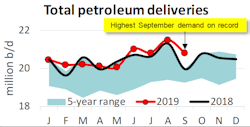Although geopolitics and trade tensions continued to rankle global oil markets in September, the US market remained relatively insulated, according to the latest monthly statistical report from the American Petroleum Institute.
First, US domestic petroleum demand, as measured by total domestic deliveries, was 20.8 million b/d—its highest level on record for the month of September. This was a seasonal decrease of 3.2% from August but an increase of 3.5% compared with September 2018. Year-to-date through September, total petroleum demand averaged 20.5 million b/d, up 0.3% year over year and the strongest level since 2007.
Consumer gasoline demand, measured by total motor gasoline deliveries, was 9.3 million b/d in September. This represented a seasonal decrease of 5% from August but was up by 1.3% compared with September 2018. Year-to-date through September, however, gasoline demand decreased by 0.4% year-over-year.
In September, distillate deliveries of 3.9 million b/d decreased by 1% from August and 3.2% compared with September 2018. Cumulatively through September, distillate deliveries decreased 1.6% year-over-year.
Kerosene jet fuel demand at 1.7 million b/d in September fell below its 2018 levels for only the second time so far this year. This was a decrease of 1.9% compared with September 2018 and 11.3% below August—the largest seasonal decrease for September since 2001 and the Sept. 11 attacks on New York and Washington. The International Air Transport Association has not yet reported data for September but suggested in its Oct. 9 report that the US-China trade war has weighted heavily on air cargo with trade volumes down 1% year-over-year in September.
Residual fuel oil deliveries were 365,000 b/d in September, which was an increase of 2% from August and 4.6% compared with September 2018. This also was the highest level so far this year, just months in advance of tighter marine fuel sulfur specifications taking effect in January 2020.
Refining and petrochemical deliveries of liquid feedstocks, naphtha, and gas oil were at their highest ever in September at 5.7 million b/d. This was an increase of 1.1% from August and the highest monthly level on record.
Supply, trade
In September, the US recorded a new record 12.4 million b/d for crude oil production and sustained record natural gas liquids production of 4.8 million b/d. The production records came despite less drilling activity in September.
Baker Hughes Co. reported oil-targeted rigs decreased by 7.2% between July and September. The US Energy Information Administration estimates the backlog of drilled but uncompleted wells declined below 8,000 in August from previously reported peaks above 8,500 wells.
US petroleum exports rose to 8.2 million b/d in September from 8.1 million b/d in August. Meanwhile, imports fell by 1 million b/d between August and September to their lowest level for the month since 1993.
Overall US petroleum net imports decreased to 800,000 b/d in September—the second lowest level this year and a step closer to the US becoming a net exporter.
Refining operations, inventories
In September, gross inputs to US refineries of 17 million b/d implied a capacity utilization rate of 90.2%. These marked notable slowing from August, which had the highest refinery throughput and capacity utilization rates so far this year.
US total petroleum inventories were 1.32 billion bbl for the month, including crude oil and refined products but excluding the Strategic Petroleum Reserve. Inventories increased despite crude oil stocks falling to their lowest level so far this year.
Macroeconomics
API’s Distillate Economic Indicator, which includes industry fundamentals, prices, and interest rates, had a reading of 0 (+0.03) in September and also a 3-month average reading of 0 (-0.03), which historically has corresponded with slowing US industrial production.
The Institute for Supply Management’s Purchasing Managers Index again signaled a contraction of industrial activity in September with a reading of 47.8%. New orders, production, and employment each decreased, while supplier deliveries slowed and indicators covering trade, supplier backlogs, inventories, and raw materials weakened.
While leading indicators of industrial activity signaled a slowing through most of this year, consumer sentiment remained optimistic. The University of Michigan’s consumer sentiment index increased to 96 as of early October, up from 93.2 in September but down from 98.6 in August. These readings suggest solid consumer sentiment, and the survey noted household real income expectations have risen to their most favorable level in 2 decades.


